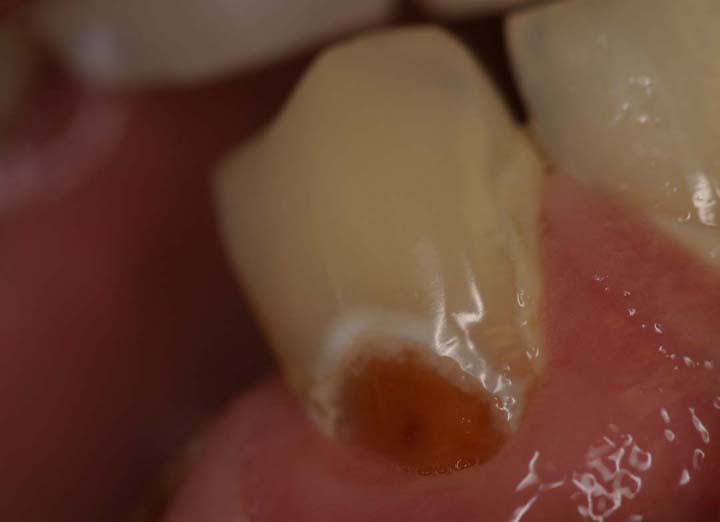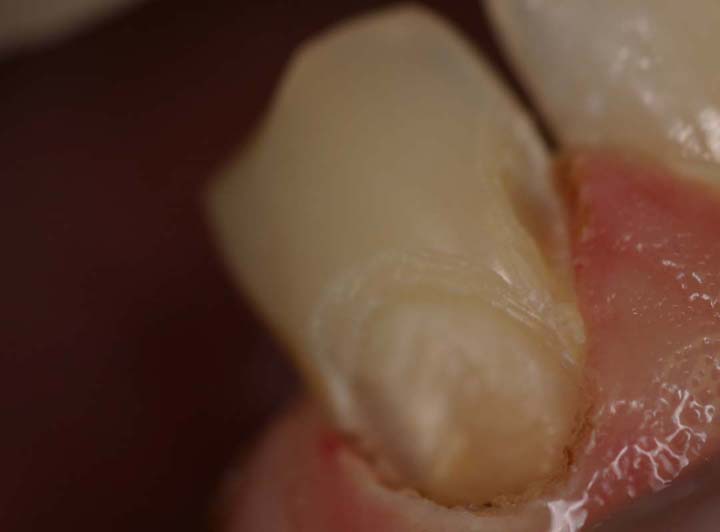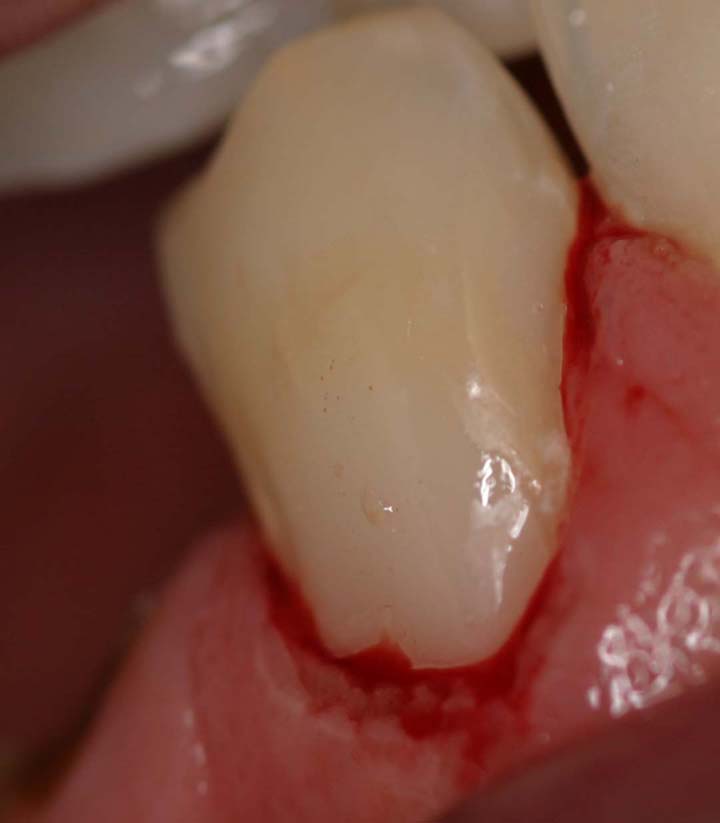Forums › Laser Treatment Tips and Techniques › Soft Tissue Procedures › Another case where the diode helped me
- This topic is empty.
-
AuthorPosts
-
Glenn van AsSpectatorHi folks, its late and I am tired but no posts recently so I thought I would show you a toughie I had today.
Patient came in for checkup and mentioned food entrapment between lower left first and 2nd molars. The 2nd molar was trapped under the first molar ( I hate restoring these) and he had a huge cleft in the tissue from flossing.
I took a PA …..phew good thing I did and I included those at the end for you. Massive decay.
I hate restoring these too. Well we anesthetized today and did glorified caries control to see how the teeth would settle down.
The decay was huge on the teeth and interesting enough the teeth had no decay around 1.5 years ago when he had his last xrays. Large bone loss due to food entrapment and a nice open contact now.
I got all the decay out ( it was tough to see that deep) and the diode at 1.0w Continuous wave really helped me get the tissue coagulated (it was inflamed alot) and also removed so I could place the matrices.
I did the deeper first molar first without any exposures but was it ever close…..
Core Buildup done with Glass Ionomer in the base and resin overtop (learned this from watching Graeme Milicich ) and seeing Ron Schalter do it as well. Sandwhich technique.
Finally filled the 2nd molar with resin and took a postop PA.
Who says that both teeth will need endo, who says one tooth.
I am going to do a crown on the first molar and leave the 2nd molar with the resin unless it needs endo. The caries control is done now and I will reevaluate in 2-3 months to see how he is doing.
He had no pain from the teeth preop but knew the decay.
I cant tell you how hard it is to photo this stuff as it is tipped and tough to see there so please excuse the quality of the photos.
Hope you like it and these are tough. The crown may need interproximal crown lengthening with the erbium but at least the decay is out.
I find these ones really tough to see with low mag, how about the rest of you.
Glenn



Robert Gregg DDSSpectatorHi Glenn,
Nice result on a tough case.
Gotta remove that tissue when it’s that inflamed.
Did you use your diode CW and “activated” or free-beam?
Bob
kellyjblodgettdmdSpectatorGlenn – WOW! Nice work. I get a headache just thinking about the patience it takes to do these.
I’m curious, do you use the CRT bacteria kit in your office? I would be concerned with this patient’s level of infectivity of Strep mutans and lactobacillus. Did this patient have other teeth which were carious?
Kelly
Glenn van AsSpectatorHi Bob and Kelly: Bob I did use it activated in this case, it just doesnt remove the tissue in the non activated tip until tissue gets cooked on the end.
Then it cuts!!
I used the laser at 1.0 w Continuous wave and it works well for these kinds of cases. The tissue is so inflamed from the food impaction and flossing all the time that it will bleed like crazy with the Er:YAG but of course with other wavelengths there will be no bleeding at all.
GRIN
Kelly-in all honesty this patient has been with me for around 5 years and never had a restoration placed. He is a great flosser but for whatever reason there developed an open contact that the upper molar was plunging into and he kept getting food piled into it . I think part of the problem is the way the 2nd molar was tipped into the distal of the first molar.
It is an isolated area but I dont have the CRT kit. Tell me a little bit about it , how it works and if you like it.
What do you do when you find the bacteria to be high?
Thanks for the interesting post.
These cases are very tough in my opinion to do well and to get a nice result on them with tight contacts, decay all the way out and not hitting the pulp.
Glenn
kellyjblodgettdmdSpectatorGlenn – Thanks for the info. This guy has no idea how lucky he is to get the treatment you provided him. I don’t know about you, but in my experience using Er lasers, even when I do have a pulpal exposure, they don’t have post op symptoms after RRGI build up and restoration. This is so different from when I only used high-speed hand pieces. I would always tell them, “You’re probably going to need a root canal.” Now I’m finding that this is almost never the case. What a “Win” for the patient!
The CRT bacteria kit is manufactured by Ivoclar. It is used inconjunction with the CAMBRA. While I’m interviewing the patient assessing risk factors for caries succeptibility (sp?), I have them chew on the paraffin wax and spit into the measuring cup that comes with the kit. This allows me to measure their salivary flow rate and collect a salivary sample at the same time. You then coat two agar plates with the saliva, drop a NaOCL tablet into the saliva at the bottom of the vial, and then seal it up and place it into a small oven for 49 hours. I then take it out, take pictures of both sides (the agar plates with bacterial colonies) putting the digital pictures into the patient’s digital chart. If their risk level is high enough that treatment is needed, I then have the patient do a one minute rinse with straight betadine. This protocol was passed on to me from V. Kim Kutsch. He said that the protocol replaced the old protocol of having the patient rinse twice/day with Peridex for two months. The betadine rinse is nice, because, as I understand it, it provides a window of non-infectivity of 2-3 months. During this time you are controlling caries and minimizing all of the other risk factors that you can control.
I love the kit and how it has helped bring a great deal of understanding to my patients and why they get cavities. It seems so simple, it’s almost ridiculous. We know that cavities are caused by bacteria, but we (dentists as a whole) don’t manage the infection. We just treat the syptoms.
Sorry such a long answer. I do think that this kit provides a lot of good information and is very helpful in patient education.
Talk with you soon.
Kelly
ASISpectatorHi Glenn, Bob & Kelly & to All,
The best of the Happy New Year to all.
These deep interproximal carious ones are always so tough to treat. You did a great job in managing the situation, Glenn. At least you have the scope and the lasers to work with.
Doesn’t it make you wonder how others without magnification and lasers treat these cases and the predicatability of the outcome? The right tools certainly render a difficult situation easier to handle. But never the less, a real challenge everytime. Glenn, just be thankful that the dacay is not at the distal of the second molar.
Andrew
dkimmelSpectatorGlenn, I can not believe yo posted a case like this? There is soooo much wrong with case. Let me just count the ways!!
1. Oops can’t find any! I’ll catch you next time!!David
Nice case.
Glenn van AsSpectatorHi Guys: this is the comfort zone on LDF, now in other forums I have to watch what I put up. It makes people feel uncomfortable and they get all hot under the collar. My dentistry is alot better with the scope and lasers than when I didnt have them and my results for the first 10 years of my practice werent bad but they werent good either.
I do decent dentistry now because I can see what I am doing and so often the lasers help out big time.
Check out the post I am gonna put in the hard tissue segment today.
Finally, something Mark Colonna hasnt talked or written about!!!!!
Not a crown or veneer prep!
Now David, you always know how to make me feel anxious first and then laugh, thanks for that.
There is still things wrong with it but less than what I used to do.
Andrew: Happy new year to you and all who post here. Thanks for the kind words. As I mentioned , I need the scope and laser to do the best work I can do but others are amazing without these aids. It made my life easier and more fun.
As for the decay on the 2nd molars , I refer those to you, you got the scope and lasers and better hands than me!!!
Kelly , cool stuff. You know what , we did that in dental school because they were working on a kit for a company and we did that exact test. Thanks man, you are a wealth of information. Do you know where we can order betadine? What is it.
Kim Kutsch is a great guy and although we disagree on a few things, I really admire his generosity in sharing what he knows, and his knowledge about microdentistry is vast. I wish I had a chance to hear him speak when he came here for Biolase but I was barred from getting in, even after getting a nice personal invitation from Biolase and Kim himself. Maybe one day they will allow me to come to WCLI.
All the best to everyone for a great new year and thanks again.
Glenn
kellyjblodgettdmdSpectatorGlenn – I simply went down to my local pharmacy and asked them to order me two half gallons (I guess that would be a couple 2-liters in your neck of the woods – my weak attempt at Canadian humour). Using only one ounce/ patient, this stuff lasts a long time.
It is the same brown iodophore solution that is used in the OR (that’s operating room, not Oregon, where Kim and I live). Obviously, it kills bugs. That’s why it is the most effective thing to use prior to surgery. It won’t stain restorations, but may alter your sense of taste for 8-12 hours.
The form I am using to do my caries analyses is a PDF file that I downloaded from the website of the California Dental Association. What I like about using it is that it helps me formalize my questions. I tend to be a talker, and sometimes forget to ask all the right questions. This helps me cover everything I need to cover.
I’d be happy to email the CAMBRA form to you if you’d like.
Talk to you soon.
Kelly
Glenn van AsSpectatorKelly, that is great information and something Kim and others have talked about is the value of a caries risk assessment for all patients, something I am not currently doing.
Could you email me the form, I would be interested in seeing what it has to say.
Thanks a bunch, I never had heard about betadine, neat stuff.
Thanks again.
Glenn
gygdmdSpectatorHi, I am a freshman here and just register. This is a great forum. I have no experience with laser at all. I become interested in laser now because you guys are so generous to share your experiences. What laser do you suggest to buy first as a beginner? BTW, Is there any study regarding the CRT and prevention of caries by betadine? Thanks.
Respectful,
Yam
AnonymousGuestYam, Welcome to the forum!
Please tell us a little more about what you want to do with a laser and that will determine what recommendations you receive.
As far as the betadine rinses , I believe Doug Young in Ca. is the guy w/ the info. I’m sure one of the Biolase lecturers can get you his contact info as he has been at some of their presentations.
gygdmdSpectatorRon,
Thanks for respnding. I would like a machine to help me do hard tissue( bone & teeth ) and soft tissue(incision and coagulation) procedures. Thanks again.warm regards,
Yam
jetsfanSpectatorJust added an 810 diode and already find it invaluable. Here is a case where both ER and diode were used. Only Ron K’s topical employed. Setting on diode was .8W cm. As this was first time I used it for this, I am looking for input. Is this the way the gingiva should look or did I use too much juice?”Bleeding occurred during finishing. Sorry for the size of pictures.
 <img src="
<img src="[img]https://www.laserdentistryforum.com/attachments/upload/cl v prep1.jpg” border=”0″>


Robert.
Lee AllenSpectatorKelly,
I would like the CAMBRA form as well as I have just initiated the caries risk assessment by CRT in my office. Thanks ahead of time.
Glenn, I found that there are lots of sources for Betadine but the strenghts vary, and you want the 10% solution, not the hand scrub nor the 1% mouth rinse. I checked this weekend with Kim on that very question and got that answer straight from the horses mouth. Which reminds me that some of the sources are veterinary! If I got the stuff from a vet, my staff would have me committed.
good luck.
A gallon lasts how long?
-
AuthorPosts
